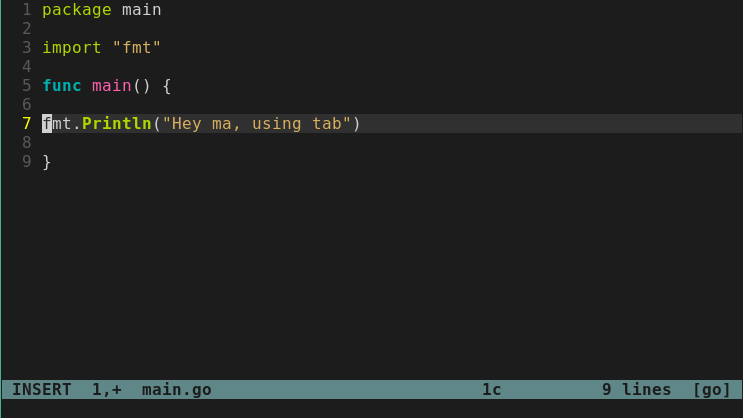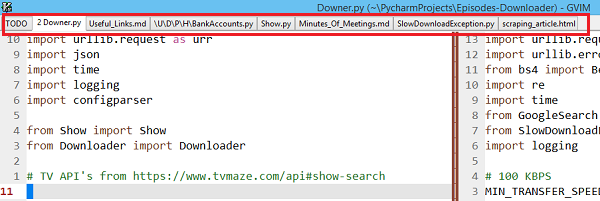
vim already has this facility for C/C++ developers, you only need to tell it about it. This is why colon commands are simpler, and so is using syntax highlighting. So by example, if I want to temporarily set tabstop at eight spaces, I can issue :set tabstop=8, or add this setting permanently to ~/.vimrc thusly: echo "set tabstop=8" > ~/.vimrc By now you know that vim colon commands start with a : while in command mode, and settings reside in ~/.vimrc and can be added there by using the exact same syntax, minus the colon. I don’t want to repeat the idea that I outlined last time: it all depends on the coding style you’re following, whether you chose it or you had to. All in all, it becomes obvious that you can, just as you can with emacs, make vim an IDE and the only tool to use when programming. Of course, I didn’t repeat the plugins that I’ve already described before, so don’t think these are the only three addons in Gentoo. This is to be noticed in our search and here are some interesting packages, depending on your preferences: vim-r (for R development), vimpress for managing WordPress blogs or zencoding-vim for HTML/CSS developers. Gentoo is known, alongside Debian, to have wealthy repositories. As I could understand it, improved functionality in binary form is named in the form “vim-“, while syntax files are named inversely, like “-vim”.


Some of those would be fluxbox-vim-syntax, for the Fluxbox configuration files, glusterfs-vim, vim-clustershell, vim-nerdtree or uzbl-vim. In Fedora’s repositories (the version used is 17) offer some interesting add-ons. Some recommendations would be: vim-plugins (searching for it with pacman will list the individual contents), vim-align, vim-pastie, vim-supertab or vim-timestamp. The reason I’m actually suggesting this is because it seems there are a lot of interesting tools here related to vim.
Vim supertab update#
If not, edit /etc/nf and uncomment it, then update with -Syu. If you’re using Arch, make sure you have the community repository enabled. vim extension and are written in Vimscript.
Vim supertab install#
You can also install “vim-scripts”, which packages the useful scripts provided by vim in the source tree in the runtime/ directory. Install what you think you need, depending on what you’re working on, noting that in Debian, the syntax for such packages’ names are something like “vim-$language”. There is also an addon-manager that was created to help you … manage the vim addons. I will start with my Debian testing installation, which lists a few addons for various languages, including Perl, TeX, Lua, Python or Ruby. I will do a search for the ‘vim’ keyword on each of them and give you some tips and pointers on what you can install, then we’ll go language-specific. The distributions I have available to me at this point are Debian, Fedora, Gentoo and Arch.
Vim supertab how to#
And, for your convenience, we’ll tell you how to install via your package manager anyway. Installing such addons is as simple as copying a file to a location, nothing more. That’s because many maintainers tend to package stuff with respect to their personal preference, which might or might not be in concordance with yours. Just as before, a little advice: although this is influenced by personal preference, experience says it works namely, install scripts/addons/color schemes directly from the source, regardless if your distro offers it as well. Many things will probably work on 7.x or maybe even 6.x, but there’s no guarantee. Of course, some recent version, not older than 7.3.x. That is because although you can learn the basics on, say, nvi, the things that interest us (since you already know the basics) will only work on vim. Not BSD vi, not some vi extension for another editor, just vim. Please remember that whatever will be talked about here is only about vim. The languagesĪlthough vim is written entirely in C, there is something named vimscript that makes creating/editing settings, sort of like Elisp in emacs, although this is a loose comparison.

If you were directed here from somewhere else, here’s what we’re gonna do: we’ll take some popular programming language (space permitting) and show you how to tweak vim so it will became more fit for coding in that language. If you read the customizing emacs article, you already have a good idea on how this article is going to be structured.

So you must have the following profile for this article to be really useful to you: you know your way around programming, so you subsequently know what you would like in an editor, and you also know your way around vim, preferably more than what we talked about in the article dedicated to it. Of course, we wouldn’t have had it any other way: we wanted to be fair, as pledged, so here is the vim article, which is a counterpart of our last one on how to make your editor the perfect programming environment.


 0 kommentar(er)
0 kommentar(er)
